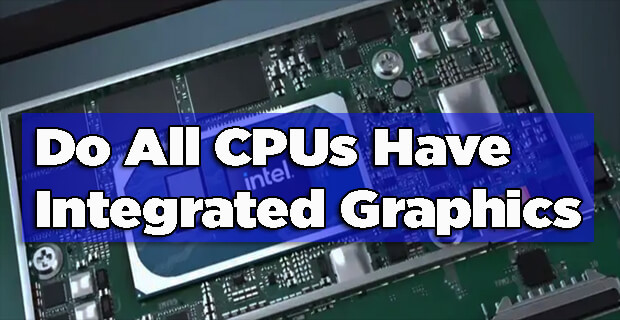In the ever-evolving landscape of computer hardware, understanding the role and prevalence of integrated graphics within CPUs is crucial for informed decision-making. The question, “Do all CPUs have integrated graphics?” holds significance, especially when choosing components for your computing needs. This guide aims to unravel the intricacies of this topic, shedding light on the advantages, disadvantages, and practical implications of integrated graphics in CPUs.

What Are Integrated Graphics?
Integrated graphics, or integrated GPU, is when the graphics processing unit (GPU) is part of the same chip as the CPU. This integration saves space and power in a computer system.
The Role of Integrated Graphics –
Integrated graphics are vital for managing computer graphics tasks, though they may not match dedicated graphics cards in performance. Nevertheless, they excel at everyday computing functions like web browsing, office work, and media consumption. Read: How Long Does CMOS Battery Last?
For most users, integrated graphics suffice for gaming and multimedia enjoyment. Plus, they eliminate the need for a separate graphics card, which lowers overall system costs and reduces power consumption.
Types of CPUs with Integrated Graphics –
Integrated graphics can be found in various types of CPUs, depending on the intended use case:
Desktop CPUs:
Many desktop CPUs, especially those designed for mainstream consumers, come equipped with integrated graphics. These CPUs are commonly used in office PCs and home computers.
Laptop CPUs:
Integrated graphics are prevalent in laptop CPUs to save space and power, making them suitable for portable devices.
Mobile CPUs:
Mobile processors, commonly found in smartphones and tablets, often incorporate integrated graphics to handle the display and graphical demands of mobile applications.
CPUs Without Integrated Graphics –
While integrated graphics are common, not all CPUs have them. Some CPUs are designed without integrated graphics, and these are typically found in the following scenarios:
Server CPUs:
Servers often rely on dedicated graphics solutions or no graphics at all since they are managed remotely and do not require a local graphical interface.
Enthusiast-grade CPUs:
High-end CPUs targeting enthusiasts and gamers often graphics, as users in this category typically opt for dedicated graphics cards for superior gaming performance.
Advantages of CPUs with integrated graphics include:
- Cost-efficiency: They are more affordable as they don’t require a separate GPU.
- Energy efficiency: They consume less power, reducing energy costs and extending laptop battery life.
- Compact design: Ideal for slim laptops and small PCs due to their integrated graphics.
Disadvantages of CPUs with Integrated Graphics:
- Limited gaming performance, not suitable for demanding games.
- Inability to support multiple high-resolution displays.
- Limited video editing capabilities, insufficient for professional tasks.
How to Identify CPUs with Integrated Graphics?
To check if a CPU includes integrated graphics, consult the manufacturer’s specifications and naming conventions. Manufacturers like Intel and AMD typically use indicators like “G” in the CPU model name, such as Intel Core i7-1165G7 or AMD Ryzen 5 3400G, to denote the presence of integrated graphics.
Choosing the Right CPU for Your Needs –
When selecting a CPU, consider your specific requirements:
For gaming, selecting a CPU with integrated graphics is a prudent choice when working with a limited budget. However, avid gamers should consider CPUs without integrated graphics and allocate their resources toward a dedicated graphics card for superior performance.
Content creators and professionals should lean towards CPUs with graphics for tasks like video conferencing and light photo editing. Office users and general consumers can benefit from CPUs with integrated graphics, as they are more than capable of handling everyday computing tasks.
Future Trends –
The CPU industry is constantly evolving, and we can expect several trends to shape the future of CPUs with graphics:
The rise of discrete GPUs: As demanding applications and gaming become more prevalent, dedicated graphics cards are expected to maintain their importance alongside integrated graphics.
Enhanced integrated graphics: Integrated graphics are likely to become more powerful and capable, offering better performance for gaming and content creation.
Do ryzen cpus have integrated graphics?
Ryzen CPUs from AMD come in two varieties: some have integrated graphics (APUs), while others do not (CPUs). APUs are suitable for systems without dedicated graphics, while CPUs are designed for use with separate graphics cards. Check product details for the specific model’s features.
Conclusion:
In conclusion, the presence of integrated graphics in CPUs is far from universal. While they offer cost-efficiency, energy savings, and compact designs, they do come with limitations in gaming and graphical tasks.
Your choice of CPU should align with your specific computing requirements, whether it involves use, gaming, or professional tasks. By understanding the role of graphics, you can make informed decisions about the CPUs that best suit your needs and budget.
